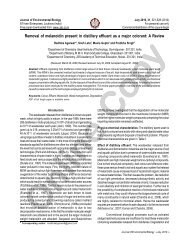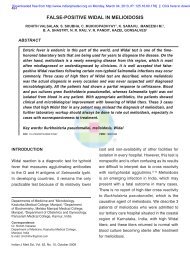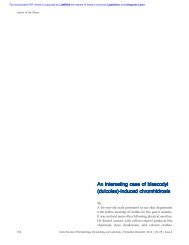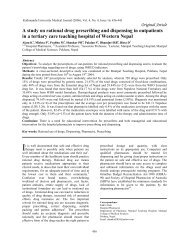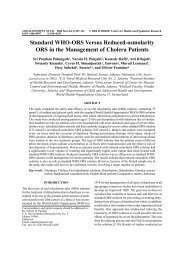Effect of ion‑implantation on surface characteristics of nickel titanium ...
Effect of ion‑implantation on surface characteristics of nickel titanium ...
Effect of ion‑implantation on surface characteristics of nickel titanium ...
Create successful ePaper yourself
Turn your PDF publications into a flip-book with our unique Google optimized e-Paper software.
[Downloaded free from http://www.ijdr.in <strong>on</strong> Tuesday, October 01, 2013, IP: 125.16.60.178] || Click here to download free Android applicati<strong>on</strong> for this journal<br />
Original Research<br />
<str<strong>on</strong>g>Effect</str<strong>on</strong>g> <str<strong>on</strong>g>of</str<strong>on</strong>g> i<strong>on</strong>-implantati<strong>on</strong> <strong>on</strong> <strong>surface</strong> <strong>characteristics</strong> <str<strong>on</strong>g>of</str<strong>on</strong>g> <strong>nickel</strong><br />
<strong>titanium</strong> and <strong>titanium</strong> molybdenum alloy arch wires<br />
Manu Krishnan, Seema Saraswathy 1 , Kalathil Sukumaran 2 , Kurian Mathew Abraham 3<br />
Department <str<strong>on</strong>g>of</str<strong>on</strong>g> Dental Research<br />
and Implantology, Institute <str<strong>on</strong>g>of</str<strong>on</strong>g><br />
Nuclear Medicine and Allied<br />
Sciences (INMAS), Defence<br />
Research and Development<br />
Organizati<strong>on</strong> (DRDO), Ministry<br />
<str<strong>on</strong>g>of</str<strong>on</strong>g> Defence, Govt <str<strong>on</strong>g>of</str<strong>on</strong>g> India,<br />
Timarpur, Delhi, 1 School <str<strong>on</strong>g>of</str<strong>on</strong>g><br />
Medicine and Paramedical<br />
Health Sciences, Indraprastha<br />
University, Delhi, 2 Materials<br />
and Minerals Divisi<strong>on</strong>, Nati<strong>on</strong>al<br />
Institute for Interdisciplinary<br />
Science and Technology,<br />
Council <str<strong>on</strong>g>of</str<strong>on</strong>g> Scientific and<br />
Industrial Research, Industrial<br />
Estate, Thiruvananthapuram,<br />
3<br />
Department <str<strong>on</strong>g>of</str<strong>on</strong>g> Biostatistics,<br />
Mar Thoma College, Mahatma<br />
Gandhi University, Thiruvalla,<br />
Kerala, India<br />
Received : 11-10-12<br />
Review completed : 07-02-13<br />
Accepted : 05-03-13<br />
ABSTRACT<br />
Aim: To evaluate the changes in <strong>surface</strong> roughness and fricti<strong>on</strong>al features <str<strong>on</strong>g>of</str<strong>on</strong>g> ‘i<strong>on</strong>-implanted<br />
<strong>nickel</strong> <strong>titanium</strong> (NiTi) and <strong>titanium</strong> molybdenum alloy (TMA) arch wires’ from its c<strong>on</strong>venti<strong>on</strong>al<br />
types in an in-vitro laboratory set up.<br />
Materials and Methods: ‘I<strong>on</strong>-implanted NiTi and low fricti<strong>on</strong> TMA arch wires’ were assessed<br />
for <strong>surface</strong> roughness with scanning electr<strong>on</strong> microscopy (SEM) and 3 dimensi<strong>on</strong>al (3D) optical<br />
pr<str<strong>on</strong>g>of</str<strong>on</strong>g>ilometry. Fricti<strong>on</strong>al forces were studied in a universal testing machine. Surface roughness<br />
<str<strong>on</strong>g>of</str<strong>on</strong>g> arch wires were determined as Root Mean Square (RMS) values in nanometers and Fricti<strong>on</strong>al<br />
Forces (FF) in grams.<br />
Statistical Analysis Used: Mean values <str<strong>on</strong>g>of</str<strong>on</strong>g> RMS and FF were compared by Student’s ‘t’ test and<br />
<strong>on</strong>e way analysis <str<strong>on</strong>g>of</str<strong>on</strong>g> variance (ANOVA).<br />
Results: SEM images showed a smooth topography for i<strong>on</strong>-implanted versi<strong>on</strong>s. 3D optical<br />
pr<str<strong>on</strong>g>of</str<strong>on</strong>g>ilometry dem<strong>on</strong>strated reducti<strong>on</strong> <str<strong>on</strong>g>of</str<strong>on</strong>g> RMS values by 58.43% for i<strong>on</strong>-implanted NiTi (795.95<br />
to 330.87 nm) and 48.90% for TMA groups (463.28 to 236.35 nm) from c<strong>on</strong>trols. N<strong>on</strong>etheless,<br />
the corresp<strong>on</strong>ding decrease in FF was <strong>on</strong>ly 29.18% for NiTi and 22.04% for TMA, suggesting<br />
partial correcti<strong>on</strong> <str<strong>on</strong>g>of</str<strong>on</strong>g> <strong>surface</strong> roughness and disproporti<strong>on</strong>ate reducti<strong>on</strong> in fricti<strong>on</strong>al forces with<br />
i<strong>on</strong>-implantati<strong>on</strong>. Though the reducti<strong>on</strong>s were highly significant at P < 0.001, relati<strong>on</strong>s between<br />
<strong>surface</strong> roughness and fricti<strong>on</strong>al forces remained n<strong>on</strong> c<strong>on</strong>clusive even after i<strong>on</strong>-implantati<strong>on</strong>.<br />
C<strong>on</strong>clusi<strong>on</strong>: The study proved that i<strong>on</strong>-implantati<strong>on</strong> can significantly reduce the <strong>surface</strong><br />
roughness <str<strong>on</strong>g>of</str<strong>on</strong>g> NiTi and TMA wires but could not make a similar reducti<strong>on</strong> in fricti<strong>on</strong>al forces.<br />
This can be attributed to the inherent differences in stiffness and <strong>surface</strong> reactivity <str<strong>on</strong>g>of</str<strong>on</strong>g> NiTi<br />
and TMA wires when used in combinati<strong>on</strong> with stainless steel brackets, which needs further<br />
investigati<strong>on</strong>s.<br />
Key words: Fricti<strong>on</strong>al forces, optical pr<str<strong>on</strong>g>of</str<strong>on</strong>g>ilometry, root mean square roughness<br />
INTRODUCTION<br />
Surface topographic features <str<strong>on</strong>g>of</str<strong>on</strong>g> orthod<strong>on</strong>tic arch wires<br />
crucially influence its clinical and biologic behavior.<br />
Presently four types <str<strong>on</strong>g>of</str<strong>on</strong>g> arch wire alloys are used in<br />
orthod<strong>on</strong>tics: Stainless steel (SS), cobalt chromium (Co-Cr),<br />
<strong>nickel</strong> <strong>titanium</strong> (NiTi), and <strong>titanium</strong> molybdenum alloy/<br />
beta <strong>titanium</strong> (TMA). Surface roughness <str<strong>on</strong>g>of</str<strong>on</strong>g> these arch wires<br />
using laser spectroscopy and specular reflectance were first<br />
Address for corresp<strong>on</strong>dence:<br />
Lt Col (Dr) Manu Krishnan<br />
E mail: manukrishnanin@yahoo.co.in<br />
411<br />
Quick Resp<strong>on</strong>se Code:<br />
Access this article <strong>on</strong>line<br />
Website:<br />
www.ijdr.in<br />
PMID:<br />
***<br />
DOI:<br />
10.4103/0970-9290.118375<br />
reported by Kusy et al., [1] in 1988 and was followed by several<br />
other experiments; [2-8] findings <str<strong>on</strong>g>of</str<strong>on</strong>g> which can be summarized<br />
as; <strong>surface</strong> roughness increases in the following order: SS<br />
< Co-Cr < TMA < NiTi. The parameters, which are related<br />
to <strong>surface</strong> roughness <str<strong>on</strong>g>of</str<strong>on</strong>g> orthod<strong>on</strong>tic arch wires, include;<br />
esthetics, fricti<strong>on</strong>al forces at arch wire bracket interface,<br />
adhesi<strong>on</strong> <str<strong>on</strong>g>of</str<strong>on</strong>g> bio-film and propensity for intra-oral corrosi<strong>on</strong>.<br />
Since fricti<strong>on</strong>al forces are generated between arch wire and<br />
bracket slot at all stages <str<strong>on</strong>g>of</str<strong>on</strong>g> treatment starting from initial<br />
leveling and alignment through space closure to finishing,<br />
and exert significant influences in the biologic mechanisms<br />
<str<strong>on</strong>g>of</str<strong>on</strong>g> tooth movement, substantial focus has been put to this<br />
aspect.<br />
The high fricti<strong>on</strong>al force associated with <strong>titanium</strong><br />
molybdenum alloy and NiTi arch wires have prompted<br />
many researchers to investigate whether this is related to<br />
its high <strong>surface</strong> roughness, but no definitive associati<strong>on</strong><br />
between the two could be derived hitherto and the current<br />
understanding is that fricti<strong>on</strong>al forces <str<strong>on</strong>g>of</str<strong>on</strong>g> orthod<strong>on</strong>tic arch<br />
wires increase in the order: SS < Co-Cr < NiTi < TMA.<br />
Indian Journal <str<strong>on</strong>g>of</str<strong>on</strong>g> Dental Research, 24(4), 2013
[Downloaded free from http://www.ijdr.in <strong>on</strong> Tuesday, October 01, 2013, IP: 125.16.60.178] || Click here to download free Android applicati<strong>on</strong> for this journal<br />
Surface characterizati<strong>on</strong> <str<strong>on</strong>g>of</str<strong>on</strong>g> low fricti<strong>on</strong> arch wires<br />
[2,9,10]<br />
A direct relati<strong>on</strong>ship between <strong>surface</strong> roughness<br />
and fricti<strong>on</strong>al forces holds good <strong>on</strong>ly for stainless steel<br />
and Co-Cr wires but not for NiTi and TMA. It, therefore,<br />
appears paradoxical that NiTi with an inherent high<br />
<strong>surface</strong> roughness produces less fricti<strong>on</strong> than TMA with<br />
a smoother exterior.<br />
NiTi and TMA wires have important roles in c<strong>on</strong>temporary<br />
pre-adjusted orthod<strong>on</strong>tic mechanotherapy. NiTi alloy<br />
possess unique properties like shape memory, superelasticity,<br />
large spring back and low stiffness which make<br />
them suitable for initial stages <str<strong>on</strong>g>of</str<strong>on</strong>g> treatment. [11] On the other<br />
hand, TMA wires with a modulus <str<strong>on</strong>g>of</str<strong>on</strong>g> elasticity approximately<br />
twice that <str<strong>on</strong>g>of</str<strong>on</strong>g> NiTi and less than half <str<strong>on</strong>g>of</str<strong>on</strong>g> SS, display adequate<br />
spring back, and ability to impart light c<strong>on</strong>tinuous forces<br />
over l<strong>on</strong>g durati<strong>on</strong>. With its added formability and<br />
weldability features, it is useful in the intermediate stages<br />
<str<strong>on</strong>g>of</str<strong>on</strong>g> treatment. [12] Many studies have pointed to the high<br />
fricti<strong>on</strong>al forces associated with NiTi and TMA arch wires<br />
compared to SS and Co-Cr. [9,13]<br />
It is in this c<strong>on</strong>text that i<strong>on</strong>-implanted/<strong>surface</strong> modified<br />
TMA and NiTi wires are introduced by quite a few<br />
manufacturers. TMA wires with i<strong>on</strong>-implantati<strong>on</strong> have<br />
shown to reduce fricti<strong>on</strong> to some extent with varying<br />
claims, [14,15] whereas evidences lack for <strong>surface</strong>-modified<br />
NiTi wires. I<strong>on</strong>-implantati<strong>on</strong> involves physical vapor<br />
depositi<strong>on</strong> <str<strong>on</strong>g>of</str<strong>on</strong>g> desirable elements <strong>on</strong> a substrate from a<br />
plasma state at energies ranging from 100-1000 electr<strong>on</strong><br />
volts and temperatures up to 700°C, mediated under<br />
vacuum c<strong>on</strong>diti<strong>on</strong>s. [16] The deposited material form<br />
compounds with the base material and creates a hard<br />
<strong>surface</strong> with high compressive forces. It thus rectifies the<br />
<strong>surface</strong> defects <str<strong>on</strong>g>of</str<strong>on</strong>g> substrate; improve its fatigue resistance,<br />
ductility and coefficient <str<strong>on</strong>g>of</str<strong>on</strong>g> fricti<strong>on</strong>. With advancements<br />
in <strong>surface</strong> metrology, n<strong>on</strong>-invasive/destructive optical<br />
methods like ellipsometry, interferometry, atomic force<br />
microscopy, and optical pr<str<strong>on</strong>g>of</str<strong>on</strong>g>ilometry are available for<br />
studying <strong>surface</strong> roughness <str<strong>on</strong>g>of</str<strong>on</strong>g> orthod<strong>on</strong>tic arch wires. [4]<br />
Optical pr<str<strong>on</strong>g>of</str<strong>on</strong>g>iling <str<strong>on</strong>g>of</str<strong>on</strong>g>fers versatility due to the ease in<br />
handling samples and in its ability to scan a wide area in<br />
short time. In this method, white light is passed through<br />
a beam filter, which directs the light to the sample <strong>surface</strong><br />
and a reference mirror. When the light reflected from<br />
two <strong>surface</strong>s recombine, a pattern <str<strong>on</strong>g>of</str<strong>on</strong>g> interference ‘fringes’<br />
emerge from the sample <strong>surface</strong> that helps in deducing<br />
<strong>surface</strong> roughness to a resoluti<strong>on</strong> <str<strong>on</strong>g>of</str<strong>on</strong>g> 0.1 nm. [17]<br />
With the launch <str<strong>on</strong>g>of</str<strong>on</strong>g> <strong>surface</strong> modified NiTi and TMA wires,<br />
it is therefore prudent to find out the relati<strong>on</strong>ship between<br />
<strong>surface</strong> roughness and fricti<strong>on</strong>al forces for such products and<br />
to evaluate its clinical utility. Therefore, aim <str<strong>on</strong>g>of</str<strong>on</strong>g> this study<br />
was to determine the <strong>surface</strong> roughness <str<strong>on</strong>g>of</str<strong>on</strong>g> i<strong>on</strong>-implanted<br />
NiTi and TMA wires with its c<strong>on</strong>venti<strong>on</strong>al counterparts<br />
using scanning electr<strong>on</strong> microscopy and optical pr<str<strong>on</strong>g>of</str<strong>on</strong>g>ilometry<br />
and the corresp<strong>on</strong>ding fricti<strong>on</strong>al forces in an in-vitro set up.<br />
Indian Journal <str<strong>on</strong>g>of</str<strong>on</strong>g> Dental Research, 24(4), 2013<br />
MATERIALS AND METHODS<br />
Krishnan, et al.<br />
Following arch wires were selected for the study: Bi<str<strong>on</strong>g>of</str<strong>on</strong>g>orce<br />
Sentalloy I<strong>on</strong>guard Nickel Titanium; I<strong>on</strong>-implanted NiTi <str<strong>on</strong>g>of</str<strong>on</strong>g><br />
0.018 × 0.025 inches (0.457 × 0.635 mm) GAC Internati<strong>on</strong>al,<br />
Inc; Central Islip, NY, and Low fricti<strong>on</strong>, I<strong>on</strong>-implanted beta<br />
<strong>titanium</strong>, TMA arch wire <str<strong>on</strong>g>of</str<strong>on</strong>g> 0.017 × 0.025 inches (0.431 ×<br />
0.635 mm), Ormco Corp, South L<strong>on</strong>e Hill Avenue, Glendora,<br />
CA. Respective dimensi<strong>on</strong>s <str<strong>on</strong>g>of</str<strong>on</strong>g> c<strong>on</strong>venti<strong>on</strong>al NiTi and TMA<br />
(C-NiTi and C-TMA) arch wires without i<strong>on</strong>-implantati<strong>on</strong><br />
from the same manufacturers were used as c<strong>on</strong>trols [Table 1].<br />
Surface features <str<strong>on</strong>g>of</str<strong>on</strong>g> arch wires were initially assessed with<br />
<strong>surface</strong> electr<strong>on</strong> micrographs at 500X magnificati<strong>on</strong>; Hitachi<br />
scanning electr<strong>on</strong> microscope, S-2400, Hitachi Instruments,<br />
Inc, San Jose, CA. Wyko NT 1100 series optical pr<str<strong>on</strong>g>of</str<strong>on</strong>g>ilometer;<br />
Veeco instruments, Inc, Woodbury NY, USA, was used<br />
for assessing the <strong>surface</strong> roughness <str<strong>on</strong>g>of</str<strong>on</strong>g> arch wires. The x,<br />
y, range <str<strong>on</strong>g>of</str<strong>on</strong>g> the c<strong>on</strong>tour map was determined by the size<br />
<str<strong>on</strong>g>of</str<strong>on</strong>g> the microscope objective and the z range or height was<br />
determined by the mechanical movement <str<strong>on</strong>g>of</str<strong>on</strong>g> the sample stage.<br />
Ten different regi<strong>on</strong>s in a 0.5 mm × 0.05 mm area <str<strong>on</strong>g>of</str<strong>on</strong>g> arch wire<br />
<strong>surface</strong> was scanned to study its topography and averages<br />
were taken. The ‘Wyko visi<strong>on</strong> s<str<strong>on</strong>g>of</str<strong>on</strong>g>tware’ <str<strong>on</strong>g>of</str<strong>on</strong>g> the equipment<br />
was used for data processing to represent <strong>surface</strong> roughness<br />
as Root Mean Square Roughness (RMS) value in nanometers.<br />
Fricti<strong>on</strong>al testing was d<strong>on</strong>e as per an in-vitro test protocol<br />
described by Tidy. [18] Fricti<strong>on</strong>al forces were measured in<br />
grams (g) using a universal testing machine (Autograph AG<br />
2000G, Schimadzu, Kyoto, Japan). Ten arch wire samples<br />
from each group were pulled for a distance <str<strong>on</strong>g>of</str<strong>on</strong>g> 16mm at a<br />
crosshead speed <str<strong>on</strong>g>of</str<strong>on</strong>g> load cell at 5 mm/minute. A c<strong>on</strong>venti<strong>on</strong>al<br />
stainless steel pre-adjusted bracket; 0.022 inch slot<br />
(0.558 mm) and an elastomeric module (Gemini series, 3M<br />
Unitek M<strong>on</strong>rovia, CA) was used for fricti<strong>on</strong> testing to ensure<br />
uniformity am<strong>on</strong>g all groups. Study was d<strong>on</strong>e under dry<br />
c<strong>on</strong>diti<strong>on</strong>s and with proprietary s<str<strong>on</strong>g>of</str<strong>on</strong>g>t ware <str<strong>on</strong>g>of</str<strong>on</strong>g> the machine,<br />
kinetic fricti<strong>on</strong>al force was determined.<br />
Student’s ‘t’ test was used for statistical comparis<strong>on</strong>s <str<strong>on</strong>g>of</str<strong>on</strong>g> mean<br />
<strong>surface</strong> roughness values and fricti<strong>on</strong>al forces. Analysis <str<strong>on</strong>g>of</str<strong>on</strong>g><br />
variance (<strong>on</strong>e-way ANOVA) was d<strong>on</strong>e to compare all tested<br />
Table 1: Study design (n = 10)<br />
Group<br />
and code<br />
C<strong>on</strong>venti<strong>on</strong>al<br />
NiTi (C-NiTi)<br />
I<strong>on</strong> guard<br />
NiTi (I-NiTi)<br />
C<strong>on</strong>venti<strong>on</strong>al<br />
TMA (C-TMA)<br />
I<strong>on</strong>-implanted<br />
TMA (I-TMA)<br />
Manufacturer Product Arch wire<br />
dimensi<strong>on</strong> in mm<br />
GAC<br />
GAC<br />
Ormco<br />
Ormco<br />
Nickel<br />
<strong>titanium</strong><br />
Nickel<br />
<strong>titanium</strong><br />
Titanium<br />
molybdenum<br />
alloy<br />
Titanium<br />
molybdenum<br />
alloy<br />
0.457 × 0.635<br />
0.457 × 0.635<br />
0.431 × 0.635<br />
0.431 × 0.635<br />
412
[Downloaded free from http://www.ijdr.in <strong>on</strong> Tuesday, October 01, 2013, IP: 125.16.60.178] || Click here to download free Android applicati<strong>on</strong> for this journal<br />
Surface characterizati<strong>on</strong> <str<strong>on</strong>g>of</str<strong>on</strong>g> low fricti<strong>on</strong> arch wires<br />
Krishnan, et al.<br />
groups together. A probability value, P < 0.05 was c<strong>on</strong>sidered<br />
as significant.<br />
RESULTS<br />
Figures 1-4 shows the SEM images <str<strong>on</strong>g>of</str<strong>on</strong>g> c<strong>on</strong>venti<strong>on</strong>al and<br />
i<strong>on</strong>-implanted NiTi and TMA wires. I<strong>on</strong>-implanted<br />
groups dem<strong>on</strong>strated a smooth <strong>surface</strong> texture compared<br />
to c<strong>on</strong>trols. Surface topographic and 3D pr<str<strong>on</strong>g>of</str<strong>on</strong>g>ilometric<br />
images [Figures 5-12] showed raised and irregular peaks in<br />
c<strong>on</strong>venti<strong>on</strong>al where as i<strong>on</strong>-implanted types exhibited more<br />
or less even peaks.<br />
RMS values in nanometers and fricti<strong>on</strong>al force in gram <str<strong>on</strong>g>of</str<strong>on</strong>g><br />
c<strong>on</strong>venti<strong>on</strong>al and i<strong>on</strong>-implanted NiTi and TMA arch wires<br />
are depicted in Table 2. Surface roughness <str<strong>on</strong>g>of</str<strong>on</strong>g> c<strong>on</strong>venti<strong>on</strong>al<br />
NiTi wire was 795.95 nm and that <str<strong>on</strong>g>of</str<strong>on</strong>g> TMA was 463.28 nm.<br />
I<strong>on</strong>-implanted NiTi and TMA registered roughness values<br />
<str<strong>on</strong>g>of</str<strong>on</strong>g> 330.87 nm and 236.35 nm respectively. Statistical analysis<br />
between c<strong>on</strong>venti<strong>on</strong>al and i<strong>on</strong>-implanted groups recorded<br />
highly significant (P < 0.001) differences. The <strong>surface</strong><br />
roughness <str<strong>on</strong>g>of</str<strong>on</strong>g> i<strong>on</strong>-implanted NiTi and TMA was reduced<br />
by 58.43% and 48.90%, respectively, from c<strong>on</strong>trol groups<br />
[Figure 13]. Similarly, mean fricti<strong>on</strong>al forces (gm) also<br />
showed significant (P < 0.001) differences am<strong>on</strong>g study<br />
groups. Mean fricti<strong>on</strong>al force <str<strong>on</strong>g>of</str<strong>on</strong>g> c<strong>on</strong>venti<strong>on</strong>al NiTi and<br />
TMA were 68.36 gm and 99.81 gm, both <str<strong>on</strong>g>of</str<strong>on</strong>g> which were<br />
found reduced to 48.41 gm (29.18%) and 77.81 gm (22.04%),<br />
respectively, for i<strong>on</strong>-implanted groups [Figure 13].<br />
DISCUSSION<br />
The effects <str<strong>on</strong>g>of</str<strong>on</strong>g> bracket-arch wire material, nature <str<strong>on</strong>g>of</str<strong>on</strong>g> their<br />
<strong>surface</strong>s: Smooth/rough, size, shape, angulati<strong>on</strong>s, ligati<strong>on</strong><br />
modes, and interacti<strong>on</strong>s with saliva <strong>on</strong> orthod<strong>on</strong>tic<br />
fricti<strong>on</strong>al forces have been well documented. [9,13] This is<br />
clinically important because fricti<strong>on</strong>al forces can influence<br />
the effectiveness <str<strong>on</strong>g>of</str<strong>on</strong>g> orthod<strong>on</strong>tic materials in delivering<br />
light c<strong>on</strong>tinuous forces; that are so essential for eliciting an<br />
optimum biologic resp<strong>on</strong>se. [19] Classically, fricti<strong>on</strong> between<br />
two <strong>surface</strong>s is directly related to the features <str<strong>on</strong>g>of</str<strong>on</strong>g> opposing<br />
<strong>surface</strong>s; like <strong>surface</strong> roughness. [20,21] Indeed, it is determined<br />
Figure 1: Scanning electr<strong>on</strong> micrograph <str<strong>on</strong>g>of</str<strong>on</strong>g> c<strong>on</strong>venti<strong>on</strong>al NiTi wire at<br />
500X<br />
Figure 2: Scanning electr<strong>on</strong> micrograph <str<strong>on</strong>g>of</str<strong>on</strong>g> i<strong>on</strong>-implanted NiTi wire<br />
at 500X<br />
Figure 3: Scanning electr<strong>on</strong> micrograph <str<strong>on</strong>g>of</str<strong>on</strong>g> c<strong>on</strong>venti<strong>on</strong>al TMA wire<br />
at 500X<br />
413<br />
Figure 4: Scanning electr<strong>on</strong> micrograph <str<strong>on</strong>g>of</str<strong>on</strong>g> low fricti<strong>on</strong> TMA wire at<br />
500X<br />
Indian Journal <str<strong>on</strong>g>of</str<strong>on</strong>g> Dental Research, 24(4), 2013
[Downloaded free from http://www.ijdr.in <strong>on</strong> Tuesday, October 01, 2013, IP: 125.16.60.178] || Click here to download free Android applicati<strong>on</strong> for this journal<br />
Surface characterizati<strong>on</strong> <str<strong>on</strong>g>of</str<strong>on</strong>g> low fricti<strong>on</strong> arch wires<br />
Krishnan, et al.<br />
Figure 5: Optical pr<str<strong>on</strong>g>of</str<strong>on</strong>g>ilograph <str<strong>on</strong>g>of</str<strong>on</strong>g> c<strong>on</strong>venti<strong>on</strong>al NiTi wire<br />
Figure 6: 3D optical pr<str<strong>on</strong>g>of</str<strong>on</strong>g>ilograph <str<strong>on</strong>g>of</str<strong>on</strong>g> c<strong>on</strong>venti<strong>on</strong>al NiTi wire<br />
Figure 7: Optical pr<str<strong>on</strong>g>of</str<strong>on</strong>g>ilograph <str<strong>on</strong>g>of</str<strong>on</strong>g> i<strong>on</strong>-implanted NiTi wire<br />
Figure 8: 3D optical pr<str<strong>on</strong>g>of</str<strong>on</strong>g>ilograph <str<strong>on</strong>g>of</str<strong>on</strong>g> i<strong>on</strong>-implanted NiTi wire<br />
Figure 9: Optical pr<str<strong>on</strong>g>of</str<strong>on</strong>g>ilograph <str<strong>on</strong>g>of</str<strong>on</strong>g> c<strong>on</strong>venti<strong>on</strong>al TMA wire<br />
by the peaks <str<strong>on</strong>g>of</str<strong>on</strong>g> <strong>surface</strong> irregularities termed as ‘asperities’<br />
and to its deformati<strong>on</strong> occurring under impact <str<strong>on</strong>g>of</str<strong>on</strong>g> applied<br />
load. So there is a c<strong>on</strong>tinuous binding/notching and release<br />
or ‘stick-slip’ phenomen<strong>on</strong> between arch wire, bracket slot<br />
and ligature interface [19] which makes it a complex entity,<br />
difficult to be explained by the laws <str<strong>on</strong>g>of</str<strong>on</strong>g> fricti<strong>on</strong>. [9,18]<br />
Indian Journal <str<strong>on</strong>g>of</str<strong>on</strong>g> Dental Research, 24(4), 2013<br />
Figure 10: 3D optical pr<str<strong>on</strong>g>of</str<strong>on</strong>g>ilograph <str<strong>on</strong>g>of</str<strong>on</strong>g> c<strong>on</strong>venti<strong>on</strong>al TMA wire<br />
Beta <strong>titanium</strong> or TMA alloy has a compositi<strong>on</strong> <str<strong>on</strong>g>of</str<strong>on</strong>g> <strong>titanium</strong><br />
(79%), molybdenum (11%), zirc<strong>on</strong>ium (6%), and tin (4%). [21]<br />
The high c<strong>on</strong>tent <str<strong>on</strong>g>of</str<strong>on</strong>g> Ti (79%) in TMA wires compared<br />
to NiTi (45-50%) increases its <strong>surface</strong> reactivity and has<br />
been attributed to its increased adhesi<strong>on</strong> to bracket slot<br />
causing higher fricti<strong>on</strong>al forces. [19] The same is said to<br />
414
[Downloaded free from http://www.ijdr.in <strong>on</strong> Tuesday, October 01, 2013, IP: 125.16.60.178] || Click here to download free Android applicati<strong>on</strong> for this journal<br />
Surface characterizati<strong>on</strong> <str<strong>on</strong>g>of</str<strong>on</strong>g> low fricti<strong>on</strong> arch wires<br />
Krishnan, et al.<br />
Figure 11: Optical pr<str<strong>on</strong>g>of</str<strong>on</strong>g>ilograph <str<strong>on</strong>g>of</str<strong>on</strong>g> low fricti<strong>on</strong> TMA wire<br />
Figure 12: 3D optical pr<str<strong>on</strong>g>of</str<strong>on</strong>g>ilograph <str<strong>on</strong>g>of</str<strong>on</strong>g> low fricti<strong>on</strong> TMA wire<br />
Table 2: Comparis<strong>on</strong> <str<strong>on</strong>g>of</str<strong>on</strong>g> root mean <strong>surface</strong> roughness<br />
(RMS) values in nm and fricti<strong>on</strong>al forces (FF) in g between<br />
c<strong>on</strong>venti<strong>on</strong>al and i<strong>on</strong>-implanted arch wires<br />
Parameter Group Mean ± SD t value P value<br />
RMS (nm) C-NiTi 795.95 11.74 81.424
[Downloaded free from http://www.ijdr.in <strong>on</strong> Tuesday, October 01, 2013, IP: 125.16.60.178] || Click here to download free Android applicati<strong>on</strong> for this journal<br />
Surface characterizati<strong>on</strong> <str<strong>on</strong>g>of</str<strong>on</strong>g> low fricti<strong>on</strong> arch wires<br />
Krishnan, et al.<br />
<str<strong>on</strong>g>of</str<strong>on</strong>g> 0.154 µm. The high roughness <str<strong>on</strong>g>of</str<strong>on</strong>g> NiTi <strong>surface</strong> was in<br />
accordance with our findings. However, it is known that laser<br />
spectroscopy measurements involve extensive mathematical<br />
calculati<strong>on</strong>s but optical pr<str<strong>on</strong>g>of</str<strong>on</strong>g>ilometry measurements are easy<br />
with modern computer algorithms. Laser spectroscopy also<br />
restricts analysis <str<strong>on</strong>g>of</str<strong>on</strong>g> data that is presentable <strong>on</strong>ly in a Gaussian<br />
pr<str<strong>on</strong>g>of</str<strong>on</strong>g>ile and RMS values need to be less than the wavelength<br />
<str<strong>on</strong>g>of</str<strong>on</strong>g> the testing laser. [4] C<strong>on</strong>versely, optical pr<str<strong>on</strong>g>of</str<strong>on</strong>g>ilometry used<br />
in this study does not have such limitati<strong>on</strong>s and allow easy<br />
computati<strong>on</strong> <str<strong>on</strong>g>of</str<strong>on</strong>g> RMS value. [17]<br />
Surface roughness <str<strong>on</strong>g>of</str<strong>on</strong>g> TMA wires was successfully altered<br />
by Burst<strong>on</strong>e and Farzin-Nia [14] using i<strong>on</strong>-implantati<strong>on</strong>.<br />
With i<strong>on</strong>-implanted TMA wires against stainless steel flats<br />
at different loads, they observed lower static and kinetic<br />
coefficient <str<strong>on</strong>g>of</str<strong>on</strong>g> fricti<strong>on</strong>s. In fact, they found values as low as<br />
stainless steel both in the dry and wet c<strong>on</strong>diti<strong>on</strong>s. However,<br />
this sweeping reducti<strong>on</strong> was not seen in the present study<br />
and can be ascribed to the differences in testing modes used<br />
by us with stainless steel pre-adjusted brackets.<br />
Bourauel et al., [4] in a comprehensive review showed RMS<br />
values <str<strong>on</strong>g>of</str<strong>on</strong>g> 0.21 µm for TMA and 0.10-1.3 µm for NiTi, which<br />
was less than the present results. They had used methods<br />
like laser specular reflectance, atomic force microscopy<br />
(AFM) and pr<str<strong>on</strong>g>of</str<strong>on</strong>g>ilometry for calibrating <strong>surface</strong> roughness<br />
and differences were expected as manufacturer variati<strong>on</strong>s<br />
and measuring methods can influence RMS values. AFM and<br />
specular reflectance use a certain regi<strong>on</strong> <str<strong>on</strong>g>of</str<strong>on</strong>g> the wire <strong>surface</strong><br />
while pr<str<strong>on</strong>g>of</str<strong>on</strong>g>ilometry uses a single line to determine the <strong>surface</strong><br />
properties which is time c<strong>on</strong>suming and difficult for samples<br />
like orthod<strong>on</strong>tic wire. It also can damage the scanned <strong>surface</strong><br />
and <str<strong>on</strong>g>of</str<strong>on</strong>g>ten mislead interpretati<strong>on</strong>. [4] Optical pr<str<strong>on</strong>g>of</str<strong>on</strong>g>iling or white<br />
light interferometry <strong>on</strong> the other hand ensures no damage<br />
to samples and facilitates accurate understanding. [17]<br />
In a major investigati<strong>on</strong> involving TMA wires with laser<br />
specular reflectance, Kusy and co-workers [6] could not find any<br />
difference in <strong>surface</strong> roughness between colored-low fricti<strong>on</strong><br />
and normal TMA wires. They found almost similar <strong>surface</strong><br />
roughness (0.195 µm) for c<strong>on</strong>venti<strong>on</strong>al and low fricti<strong>on</strong><br />
types. The fricti<strong>on</strong>al coefficients also showed negligible<br />
relati<strong>on</strong>ship with its <strong>surface</strong> roughness. Cash et al., [15]<br />
too noticed no advantages for low fricti<strong>on</strong>, colored TMA<br />
over c<strong>on</strong>venti<strong>on</strong>al but i<strong>on</strong>-implanted types showed a<br />
reducti<strong>on</strong> in fricti<strong>on</strong>al forces which were in par with the<br />
present findings. There was a discernible reducti<strong>on</strong> (RMS<br />
value: 0.463-0.236 µm) in this study for TMA groups that<br />
did not transform to an analogous reducti<strong>on</strong> in fricti<strong>on</strong>al<br />
forces. Doshi and Bhad-Patil, [8] however, reported reduced<br />
RMS and fricti<strong>on</strong>al values for low fricti<strong>on</strong> TMA with ceramic<br />
brackets but could not establish a direct correlati<strong>on</strong> between<br />
two factors which was true for the present study also.<br />
C<strong>on</strong>sidering the different methods used for <strong>surface</strong><br />
roughness estimati<strong>on</strong> and wide variati<strong>on</strong> in data available<br />
Indian Journal <str<strong>on</strong>g>of</str<strong>on</strong>g> Dental Research, 24(4), 2013<br />
with the literature, it would be better not to take these<br />
values <strong>on</strong> a universal scale for comparis<strong>on</strong>. This can be<br />
probably due to the differences in the types <str<strong>on</strong>g>of</str<strong>on</strong>g> samples<br />
and methods followed. Percentage changes in RMS and<br />
fricti<strong>on</strong>al force values may be a better opti<strong>on</strong> for judgment,<br />
until we have uniform means in this aspect. The results<br />
suggested that the currently marketed i<strong>on</strong>-implanted arch<br />
wire products cannot c<strong>on</strong>tribute to a total reducti<strong>on</strong> in<br />
<strong>surface</strong> roughness. More so, its relati<strong>on</strong>ship with fricti<strong>on</strong>al<br />
forces tends to be uncertain, even though differences were<br />
highly significant. The low stiffness <str<strong>on</strong>g>of</str<strong>on</strong>g> TMA and NiTi wires<br />
with respect to stainless steel slot bracket slot can cause<br />
bracket slot binding and possibly influence their fricti<strong>on</strong>al<br />
<strong>characteristics</strong>. This may lessen the expected advantages<br />
<str<strong>on</strong>g>of</str<strong>on</strong>g> i<strong>on</strong>-implantati<strong>on</strong>.<br />
CONCLUSION<br />
• Scanning electr<strong>on</strong> microscopic and optical pr<str<strong>on</strong>g>of</str<strong>on</strong>g>ilometric<br />
views <str<strong>on</strong>g>of</str<strong>on</strong>g> i<strong>on</strong>-implanted NiTi and TMA wires exhibited<br />
smoother <strong>surface</strong>s than c<strong>on</strong>venti<strong>on</strong>al c<strong>on</strong>trol groups.<br />
• I<strong>on</strong>-implantati<strong>on</strong> reduced the <strong>surface</strong> roughness <str<strong>on</strong>g>of</str<strong>on</strong>g><br />
NiTi and beta <strong>titanium</strong> wires by 58.43% and 48.90%,<br />
respectively, which suggested need for improving i<strong>on</strong>implantati<strong>on</strong><br />
procedures for smoother topography.<br />
• The resultant reducti<strong>on</strong> in fricti<strong>on</strong>al forces was <strong>on</strong>ly<br />
29.18% for NiTi and 22.04% for TMA that showed an<br />
uncertain relati<strong>on</strong>ship between <strong>surface</strong> roughness and<br />
fricti<strong>on</strong>al forces, even after i<strong>on</strong>-implantati<strong>on</strong> for the<br />
two materials.<br />
• Binding <str<strong>on</strong>g>of</str<strong>on</strong>g> NiTi and TMA wires with stainless steel<br />
bracket slot due to fundamental differences in stiffness<br />
and <strong>surface</strong> reactivity <str<strong>on</strong>g>of</str<strong>on</strong>g> <strong>titanium</strong> may be the probable<br />
factors that hamper the advantages <str<strong>on</strong>g>of</str<strong>on</strong>g> i<strong>on</strong>-implantati<strong>on</strong><br />
<str<strong>on</strong>g>of</str<strong>on</strong>g> NiTi and TMA wires in minimizing fricti<strong>on</strong>. This<br />
warrants more investigati<strong>on</strong>s.<br />
REFERENCES<br />
1. Kusy RP, Whitley JQ, Mayhew MJ, Buckthal JE. Surface roughness <str<strong>on</strong>g>of</str<strong>on</strong>g><br />
orthod<strong>on</strong>tic arch wires via laser spectroscopy. Angle Orthod 1988;<br />
58:33-45.<br />
2. Porosoki RR, Bagby MD, Ericks<strong>on</strong> LC. Static fricti<strong>on</strong>al force and <strong>surface</strong><br />
roughness <str<strong>on</strong>g>of</str<strong>on</strong>g> NiTi arch wires. Am J Orthod Dent<str<strong>on</strong>g>of</str<strong>on</strong>g>acial Orthop 1991;<br />
100:341-8.<br />
3. Kusy RP. A review <str<strong>on</strong>g>of</str<strong>on</strong>g> c<strong>on</strong>temporary arch wires: Their properties and<br />
<strong>characteristics</strong>. Angle Orthod 1997;67:197-207.<br />
4. Bourauel C, Fries T, Drescher D, Plietsch R. Surface roughness<br />
<str<strong>on</strong>g>of</str<strong>on</strong>g> orthod<strong>on</strong>tic wires via atomic force microscopy, laser specular<br />
reflectance, and pr<str<strong>on</strong>g>of</str<strong>on</strong>g>ilometry. Eur J Orthod 1998;20:79-92.<br />
5. Watanabe I, Watanabe E. Surface changes induced by fluoride<br />
prophylactic agents <strong>on</strong> <strong>titanium</strong>-based orthod<strong>on</strong>tic wires. Am J Orthod<br />
Dent<str<strong>on</strong>g>of</str<strong>on</strong>g>acial Orthop 2003;123:653-6.<br />
6. Kusy RP, Whitley JQ, Gurgel JA. Comparis<strong>on</strong>s <str<strong>on</strong>g>of</str<strong>on</strong>g> <strong>surface</strong> roughnesses<br />
and sliding resistances <str<strong>on</strong>g>of</str<strong>on</strong>g> 6 <strong>titanium</strong>-based or TMA-type arch wires.<br />
Am J Orthod Dent<str<strong>on</strong>g>of</str<strong>on</strong>g>acial Orthop 2004;126:589-603.<br />
7. Juvvadi SR, Kailasam V, Padmanabhan S, Chitharanjan AB. Physical,<br />
mechanical, and flexural properties <str<strong>on</strong>g>of</str<strong>on</strong>g> 3 orthod<strong>on</strong>tic wires: An in-vitro<br />
study. Am J Orthod Dent<str<strong>on</strong>g>of</str<strong>on</strong>g>acial Orthop 2010;138:623-30.<br />
8. Doshi UH, Bhad-Patil WA. Static fricti<strong>on</strong>al force and <strong>surface</strong> roughness<br />
416
[Downloaded free from http://www.ijdr.in <strong>on</strong> Tuesday, October 01, 2013, IP: 125.16.60.178] || Click here to download free Android applicati<strong>on</strong> for this journal<br />
Surface characterizati<strong>on</strong> <str<strong>on</strong>g>of</str<strong>on</strong>g> low fricti<strong>on</strong> arch wires<br />
Krishnan, et al.<br />
<str<strong>on</strong>g>of</str<strong>on</strong>g> various bracket and wire combinati<strong>on</strong>s. Am J Orthod Dent<str<strong>on</strong>g>of</str<strong>on</strong>g>acial<br />
Orthop 2011;139:74-9.<br />
9. Drescher D, Bourauel C, Schumacher HA. Fricti<strong>on</strong>al forces<br />
between bracket and arch wire. Am J Orthod Dent<str<strong>on</strong>g>of</str<strong>on</strong>g>acial Orthop<br />
1989;96:397-404.<br />
10. Kusy RP, Whitley JQ. <str<strong>on</strong>g>Effect</str<strong>on</strong>g>s <str<strong>on</strong>g>of</str<strong>on</strong>g> <strong>surface</strong> roughness <strong>on</strong> the coefficients<br />
<str<strong>on</strong>g>of</str<strong>on</strong>g> fricti<strong>on</strong> in model orthod<strong>on</strong>tic systems. J Biomech 1990;23:913-25.<br />
11. Andreasen GF, Heilman H, Krell D. Stiffness changes in thermodynamic<br />
nitinol with increasing temperature. Angle Orthod 1985;55:120-6.<br />
12. Burst<strong>on</strong>e CJ, Goldberg AJ. Beta <strong>titanium</strong>: A new orthod<strong>on</strong>tic alloy. Am<br />
J Orthod 1980;77:121-32.<br />
13. Kapila S, Angolkar PV, Duncans<strong>on</strong> M, Nanda RS. Evaluati<strong>on</strong> <str<strong>on</strong>g>of</str<strong>on</strong>g> fricti<strong>on</strong><br />
between edgewise stainless steel brackets and orthod<strong>on</strong>tic wires <str<strong>on</strong>g>of</str<strong>on</strong>g><br />
four alloys. Am J Orthod Dent<str<strong>on</strong>g>of</str<strong>on</strong>g>acial Orthop 1990;98:117-26.<br />
14. Burst<strong>on</strong>e C, Farzin-Nia F. Producti<strong>on</strong> <str<strong>on</strong>g>of</str<strong>on</strong>g> low fricti<strong>on</strong> and colored TMA<br />
by i<strong>on</strong> implantati<strong>on</strong>. J Clin Orthod 1995;29:453-61.<br />
15. Cash A, Curtis R, Garrigia-Majo D, McD<strong>on</strong>ald FM. A comparative<br />
study <str<strong>on</strong>g>of</str<strong>on</strong>g> the static and kinetic fricti<strong>on</strong>al resistance <str<strong>on</strong>g>of</str<strong>on</strong>g> <strong>titanium</strong><br />
molybdenum alloy arch wires in stainless steel brackets. Eur J<br />
Orthod 2004;26:105-11.<br />
16. Sioshansi P. Tailoring <strong>surface</strong> properties by i<strong>on</strong> implantati<strong>on</strong>. Cleveland:<br />
Materials Engineering. Pent<strong>on</strong> Publishing; 1987.<br />
17. Wyko NT1100 Optical Pr<str<strong>on</strong>g>of</str<strong>on</strong>g>iling System [Internet] 2012 Jan 15. Available<br />
from: http://ppewww.physics.gla.ac.uk/~williamc/NT1100 spec.pdf.<br />
[Last cited <strong>on</strong> 2012 April 5].<br />
18. Tidy DC. Fricti<strong>on</strong>al forces in fixed appliances. Am J Orthod Dent<str<strong>on</strong>g>of</str<strong>on</strong>g>acial<br />
Orthop 1989;96:249-54.<br />
19. Pr<str<strong>on</strong>g>of</str<strong>on</strong>g>fit WR. C<strong>on</strong>temporary orthod<strong>on</strong>tics. 3 rd ed. St Louis: C.V. Mosby;<br />
2000.<br />
20. Serway RA. Physics: For Scientists and Engineers. Philadelphia:<br />
Saunders College Publishing; 1982.<br />
21. Kapila S, Sachdeva R. Mechanical properties and clinical applicati<strong>on</strong>s<br />
<str<strong>on</strong>g>of</str<strong>on</strong>g> orthod<strong>on</strong>tic wires. Am J Orthod Dent<str<strong>on</strong>g>of</str<strong>on</strong>g>acial Orthop 1989;96:100-9.<br />
22. Andreasen GF, Morrow RE. Laboratory and clinical analysis <str<strong>on</strong>g>of</str<strong>on</strong>g> nitinol<br />
wire. Am J Orthod 1978;73:142-51.<br />
23. Eliades T, Eliades G, Athanasiou AE, Bradley TG. Surface characterizati<strong>on</strong><br />
<str<strong>on</strong>g>of</str<strong>on</strong>g> retrieved NiTi orthod<strong>on</strong>tic arch wires. Eur J Orthod 2000;22:317-26.<br />
24. S<strong>on</strong> SY, Nishida S, Hattori N, Jang HD, S<strong>on</strong> YJ. The effect <str<strong>on</strong>g>of</str<strong>on</strong>g> <strong>surface</strong><br />
treatment <str<strong>on</strong>g>of</str<strong>on</strong>g> TI-6Al-4V alloy specimens. Key Eng Mater 2005;297-300:<br />
2429-34.<br />
25. Sioshansi P. improving the properties <str<strong>on</strong>g>of</str<strong>on</strong>g> <strong>titanium</strong> alloys by i<strong>on</strong><br />
implantati<strong>on</strong>. J Miner Met Mater Soc 1990;42:30-1.<br />
How to cite this article: Krishnan M, Saraswathy S, Sukumaran K, Abraham<br />
KM. <str<strong>on</strong>g>Effect</str<strong>on</strong>g> <str<strong>on</strong>g>of</str<strong>on</strong>g> i<strong>on</strong>-implantati<strong>on</strong> <strong>on</strong> <strong>surface</strong> <strong>characteristics</strong> <str<strong>on</strong>g>of</str<strong>on</strong>g> <strong>nickel</strong> <strong>titanium</strong><br />
and <strong>titanium</strong> molybdenum alloy arch wires. Indian J Dent Res 2013;24:411-7.<br />
Source <str<strong>on</strong>g>of</str<strong>on</strong>g> Support: Nil, C<strong>on</strong>flict <str<strong>on</strong>g>of</str<strong>on</strong>g> Interest: N<strong>on</strong>e identified.<br />
Author Help: Reference checking facility<br />
The manuscript system (www.journal<strong>on</strong>web.com) allows the authors to check and verify the accuracy and style <str<strong>on</strong>g>of</str<strong>on</strong>g> references. The tool checks<br />
the references with PubMed as per a predefined style. Authors are encouraged to use this facility, before submitting articles to the journal.<br />
• The style as well as bibliographic elements should be 100% accurate, to help get the references verified from the system. Even a single<br />
spelling error or additi<strong>on</strong> <str<strong>on</strong>g>of</str<strong>on</strong>g> issue number/m<strong>on</strong>th <str<strong>on</strong>g>of</str<strong>on</strong>g> publicati<strong>on</strong> will lead to an error when verifying the reference.<br />
• Example <str<strong>on</strong>g>of</str<strong>on</strong>g> a correct style<br />
Sheahan P, O’leary G, Lee G, Fitzgibb<strong>on</strong> J. Cystic cervical metastases: Incidence and diagnosis using fine needle aspirati<strong>on</strong> biopsy.<br />
Otolaryngol Head Neck Surg 2002;127:294-8.<br />
• Only the references from journals indexed in PubMed will be checked.<br />
• Enter each reference in new line, without a serial number.<br />
• Add up to a maximum <str<strong>on</strong>g>of</str<strong>on</strong>g> 15 references at a time.<br />
• If the reference is correct for its bibliographic elements and punctuati<strong>on</strong>s, it will be shown as CORRECT and a link to the correct article<br />
in PubMed will be given.<br />
• If any <str<strong>on</strong>g>of</str<strong>on</strong>g> the bibliographic elements are missing, incorrect or extra (such as issue number), it will be shown as INCORRECT and link to<br />
possible articles in PubMed will be given.<br />
417<br />
Indian Journal <str<strong>on</strong>g>of</str<strong>on</strong>g> Dental Research, 24(4), 2013




